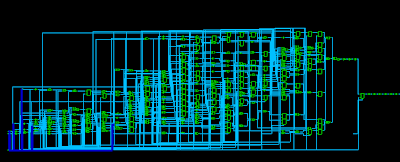When you have a large chunk of combinational logic, sometimes it is useful to create pipeline out of it. Benefits are that critical path is much lower and you can work with higher clock, whereas throughput of your circuit is still almost 1 operation/cycle. Only downside is that results are delayed a couple of cycles.
I have had a not-so-succesfull attempt to make a pipeline geneartor for verilog. But I was informed recently that synopsys design compiler has option to do this automatically.
This is design I want to pipeline.
module addxor(input [5:0] A, input [5:0] B, output C, input clock);
wire [5:0] M = A + B;
wire [5:0] N = M * M;
wire [5:0] H = A - N;
wire [5:0] J = H - B;
wire [5:0] G = A[0] ? H : J;
assign C = |G;
endmodule
pipeline_design
From the desing compiler there is a straight-forward command which is:design_vision-xg-t> pipeline_design
Retiming to the rescue
Retiming was invented in 1981, and synthesis tools such as DC use it. It allows it to move registers arround the combinational logic in order to optimize it.module addxor_pipelined(input [5:0] A, input [5:0] B, output reg C, input clock);This could be a common design pattern for pipeline, which consists of two steps:
wire C1;
addxor U1(A,B,C1,clock);
reg C2,C3,C4,C5;
always @ (posedge clock)
begin
C2 <= C1;
C3 <= C2;
C4 <= C3;
C5 <= C4;
C <= C5;
end
endmodule
- Encapsulate a combinational module; and
- Delay the output.
Without mapping/retiming this design looks like this.
 After running the compile command, design does not change much, at the end there are flip-flops in series at the output of circuit. But circuit does have a timing violations.
After running the compile command, design does not change much, at the end there are flip-flops in series at the output of circuit. But circuit does have a timing violations.
 Large squares are flip-flops, and you will notice that they are spread out through an entire design, this is what we wanted. No more timing violations. In case you are interested: my DC configuration.
Large squares are flip-flops, and you will notice that they are spread out through an entire design, this is what we wanted. No more timing violations. In case you are interested: my DC configuration.
In conclusion, with this method for pipelining, you can use same testing code for pre-synthesis and post-synthesis design.
 After running the compile command, design does not change much, at the end there are flip-flops in series at the output of circuit. But circuit does have a timing violations.
After running the compile command, design does not change much, at the end there are flip-flops in series at the output of circuit. But circuit does have a timing violations.design_vision-xg-t> source config.conVoilà!
design_vision-xg-t> compile # there will be timing violations
design_vision-xg-t> optimize_registers -period 0 -flatten
 Large squares are flip-flops, and you will notice that they are spread out through an entire design, this is what we wanted. No more timing violations. In case you are interested: my DC configuration.
Large squares are flip-flops, and you will notice that they are spread out through an entire design, this is what we wanted. No more timing violations. In case you are interested: my DC configuration.In conclusion, with this method for pipelining, you can use same testing code for pre-synthesis and post-synthesis design.
Thanks for reading, leave your comments below.